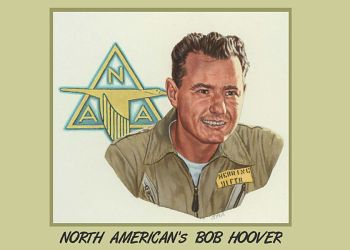 |
On the morning of 26 November 1947, 1Lt. Robert A. "Bob" Hoover accomplished a preflight of P-84B (45-59502) on the ramp at Muroc. The airplane was fully fueled, including two wingtip tanks. He then took off on a three-hour test flight to check out the Allison J-33 engine controls. Throughout the flight, Hoover took note of all engine instrument readings approximately every five minutes. There were no discrepancies and he returned to base to refuel.
While Hoover waited for the ground crew to complete servicing the aircraft, he obtained new test cards from the project engineer. He took off about an hour later for another engine control test flight.
Climbing to the west over Antelope Valley, Hoover's P-84 approached 25,000 feet altitude. He then turned to a reciprocal course and climbed to 30,000 feet. Hoover then took readings of the time, tachometer, indicated airspeed, free air temperature, oil pressure, tail pipe temperature, fuel pressure and position.
While still maintaining a climb and at an altitude of 34,000 feet, there was a disturbing noise from the engine and the jet began to vibrate violently. Engine oil pressure immediately dropped to zero and the aileron boost system became ineffective. More alarming still, the FIRE warning light came on and remained lit.
Hoover's experience with the P-84 indicated that the fire warning system was not always accurate. The warning light could indicate a fire or merely an engine overheat situation. If it was the latter then he could stop the warning indication by retarding the throttle.
Before he could retard the throttle, the engine rpm dropped rapidly. Hoover turned the fuel switches off and jettisoned the tip tanks. He noticed black smoke trailing from the airplane and experienced a slight loss of elevator control. All the while, Hoover relayed the details of his difficulties by radio to the Muroc control tower.
Still heading east toward Muroc, the P-84 had descended to 25,000 feet when the engine froze and the cockpit filled with dense smoke. To make matters worse, oil sprayed the inside of the canopy, reducing visibility. Hoover activated the electric switch to open the canopy while still flying at an indicated airspeed of 200 mph.
At 15,000 feet, Hoover pulled the nose up using elevator trim. Response to the control movement was slight, indicating that the control rods may have burned through. Upon finding his elevator controls ineffective, Hoover announced his intention to bail out. Unlike earlier models of Thunderjet, the P-84B was equipped with an ejection seat. Unfortunately, the explosive cartridge for the seat ejection mechanism was not available from the Ordnance Department at Muroc.
Unable to eject, Hoover climbed onto the canopy rail and jumped while the plane was in a 30-degree dive. The P-84 immediately pitched down and the horizontal tail struck the backs of Hoover's knees, fracturing one leg and briefly knocking him unconscious.
As he regained his senses, Hoover pulled the ripcord and opened his parachute. He landed on level ground, but was dragged some distance before coming to rest. The P-84 plunged into the edge of a plowed field, exploded and burned. Two farmers, Bill Barnes and Bill Swartz released Hoover from his harness and drove him to a hospital in Lancaster, about 20 miles away.
Accident investigators later remarked that Hoover should be "commended for his coolness and for the way he collected all data possible before abandoning the plane." They added that "the observations made by the pilot, the data recorded by him and the course of action taken by him were remarkable (considering the circumstances) and commendable."
The cause of the accident was thought to be compressor blade failure.
 |
